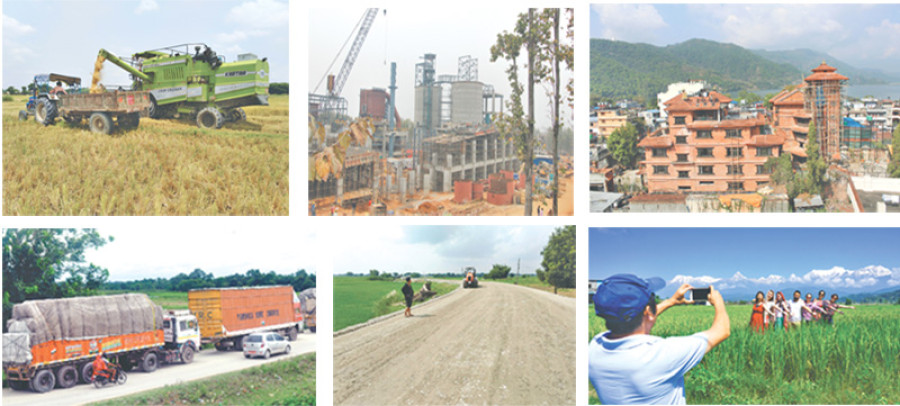Money
World Bank Report: Nepal’s GDP to grow 6pc
Nepal’s economy is expected to mark a growth rate of 6 percent in the current financial year, as strong growth is foreseen particularly in the agriculture and tourism sectors, the World Bank said on Thursday.
Sangam Prasain
Nepal’s economy is expected to mark a growth rate of 6 percent in the current financial year, as strong growth is foreseen particularly in the agriculture and tourism sectors, the World Bank said on Thursday.
In its biannual publication, Nepal Development Update 2018, the World Bank has highlighted private investments and exports as the two lagging engines of growth.
According to the report, Nepal needs strong engagement from the private sector in the development process as public financing alone would not be adequate to achieve long-term, sustainable and steady growth.
The report said that inflation is expected to hover below 5 percent, assuming a continued increase in oil prices and depreciation of the exchange rate.
“Agriculture growth is expected to increase because of the good monsoon rains that supported a great paddy yield,” the report pointed out. The agriculture sector is expected to grow by an average 4.3 percent. The Agriculture Ministry has projected that paddy output is expected to reach a record 5.66 million tonnes, up 10 percent from the 2017-18 harvest.
Besides that, the World Bank said that the industry and service sector’s growth is projected to remain strong as the government shifts from consumption to investment-based growth. Industry growth is likely to remain a healthy 8.4 percent over the forecast period as construction and manufacturing continue to perform well, the report said.
Capacity utilisation in the manufacturing sector will continue as the availability of reliable electricity improves and large cements factories come online this fiscal year. Services are expected to grow at an average of 6.3 percent per year over the forecast period. Steady remittance inflows will support growth in retail and wholesale trade.
“The continuation of growth in tourist arrivals is expected as the government implements the Visit Nepal 2020 campaign with the aim of attracting two million tourists per year, which will boost growth in the hotels and restaurants subsector,” the report said.
Based on the average 18 percent growth in tourist arrivals in the first nine months of 2018, the Nepal Tourism Board has projected that tourist numbers are expected to reach nearly 1.2 million this year.
“On the demand side, gross investment is expected to drive growth. Works on two international airports and road projects will help boost investment and gross fixed capital formation growth is expected to remain strong during the forecast period,” the report said.
“The government’s consumption is expected to grow significantly this fiscal year as soon as the fully established provincial and local governments begin operation.”
However, private investments are lagging behind, the report said. “Crowding in the private sector and maximising finance from all possible sources will be critical for Nepal’s ambitious, but realizable, target of becoming a middle-income country by 2030,” the report said.
“Obviously, to meet our development goals, 60 percent of our investment must come from the private sector,” said Finance Minister Yuba Raj Khatiwada.
“We are ready to join hands and remove bottlenecks in the areas where private sector are uncomfortable,” he said, adding that any procedural issues related to tax will be resolved. “But we want assurance from the private sector that they will work in transparent manner.”
“Selected priority reforms to crowd in the private sector are a must, along with a strong emphasis on increasing firm competitiveness and exports,” said Kene Ezemenari, World Bank’s Senior Economist and author of the update.
“Promoting financial inclusion, developing long-term financing to invest in infrastructure, strengthening public investment management and public private partnerships (PPP) are the key priorities for Nepal to position itself as a relevant global player,” she added.
However, the report highlighted that external shocks to outmigration and remittances could lead to a deterioration of the balance of payments, a reduction in the growth of savings deposits and a shortage of loanable funds and credits.
Imports are expected to continue to grow but at a slower rate, while exports will pick up slightly with the strengthening of the manufacturing sector, the report said.
“As Nepal now has strong political stability, it needs to continue taking proactive and transformative steps to attract investments to drive its development,” said Qimiao Fan, World Bank Country Director for Bangladesh, Bhutan and Nepal.
He added, “The current need for Nepal is: efficient and quality infrastructure, growth in the size of the market and transparent and conducive legal framework. The key policies and practices signal to global investors that a new ecosystem is being put in place.”
THE HIGHLIGHTS
- Private investments and exports as the two lagging engines of growth
- Agriculture sector is expected to grow by an average 4.3 percent growth
- Inflation is expected to hover below 5 percent
- Industry growth is likely to remain a healthy 8.4 percent
- Services are expected to grow at an average of 6.3 percent
- Steady remittance inflows will support growth in retail and wholesale trade
- Works on two international airports and road projects will boost investment
- The government’s consumption is expected to grow significantly
- External shocks to outmigration could lead to deterioration of the balance of payments
- Imports are expected to continue to grow but at a slower rate




 31.75°C Kathmandu
31.75°C Kathmandu














